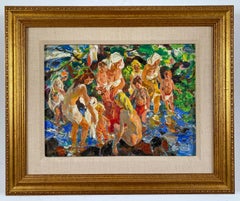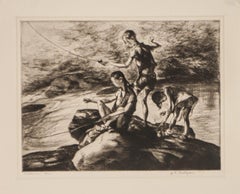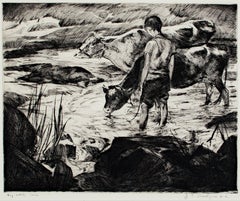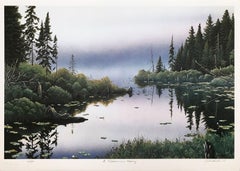John Edward Costigan Art
to
8
4
8
2
4
1
1
Overall Height
to
Overall Width
to
4
7
6
5
3
3
1
1
1
1
8
2
1
2
10
6,996
3,348
2,513
1,213
4
3
3
1
1
Artist: John Edward Costigan
Group of Workers
By John Edward Costigan
Located in San Francisco, CA
This artwork titled "Group of Workers" 1943, is an original lithograph on paper by noted American artist John Edward Costigan, 1888-1972. It is hand signed and titled in pencil by th...
Category
Mid-20th Century Realist John Edward Costigan Art
Materials
Lithograph
Bathing Group
By John Edward Costigan
Located in Sheffield, MA
John Edward Costigan, N.A.
American, 1888-1972
Bathing Group
Oil on canvas board
Signed ‘J.E. Costigan N.A.’ lower left
12 by 16 in. W/frame 20 by 24 i...
Category
1950s Post-Impressionist John Edward Costigan Art
Materials
Oil
Fisherman Three 1939 original signed etching by John E. Costigan
By John Edward Costigan
Located in Paonia, CO
Fisherman Three is an original 1939 signed etching by the American artist John E. Costigan
( 1888-1972 ) a self-taught painter and printmaker. The locale for Costigan...
Category
Mid-20th Century Other Art Style John Edward Costigan Art
Materials
Etching
Woman and Child
By John Edward Costigan
Located in Sheffield, MA
John Edward Costigan, N.A.
American, 1888-1972
Woman and Child
Oil on canvas
Signed ‘J.E. Costigan N.A.’ lower left
24 by 30 in. W/frame 32 by 38 in.
John Costigan was born of Irish-American parents in Providence, Rhode Island, February 29, 1888. He was a cousin of the noted American showman, George M. Cohan, whose parents brought the young Costigan to New York City and was instrumental in starting him on a career in the visual arts. They were less successful in encouraging him to pursue formal studies at the Art Students League (where, however, he later taught) than in exposing him to the commercial art world through the job they had gotten him with the New York lithographing firm that made their theatrical posters.
At the H. C. Miner Lithographing Company, Costigan worked his way up from his entry job as a pressroom helper, through various apprenticeships, to the position of sketch artist. In the latter capacity he was an uncredited designer of posters for the Ziegfeld Follies and for numerous silent films. Meanwhile, he had supplemented his very meager formal studies in the fine arts with a self-teaching discipline that led to his first professional recognition in 1920 with the receipt of prizes for an oil painting and watercolor in separate New York exhibitions.
A year earlier, Costigan had wed professional model Ida Blessin, with whom he established residence and began raising a family in the sleepy little rural New York hamlet of Orangeburg, the setting for the many idyllic farm landscapes and wood interiors with which he was to become identified in a career that would span half a century.
John Costigan’s first national recognition came in 1922 with his winning of the coveted Peterson Purchase prize of the Art Institute of Chicago for an oil on canvas, “Sheep at the Brook.” It marked the start of an unbroken winning streak that would gain him at least one important prize per year for the remainder of the decade. The nation’s art journalists and critics began to take notice, making him the recurring subject of newspaper features and magazine articles. The eminent author and critic Edgar Holger Cahill was just a fledgling reporter when he wrote his first feature, “John Costigan Carries the Flame,” for Shadowland Magazine in 1922. Costigan had his first one-man show of paintings at the Rehn Gallery on New York’s 5th Avenue in November, 1924, to be followed less than three years later by another at the Art Institute of Chicago. In addition, Costigan’s work has been—and continues to be included, side-by-side with that of some of America’s most high-profile artists, in museum and gallery exhibitions throughout the country. His renown had peaked in the early 1930s, by which time his work had been honored with nearly every major award then being bestowed in the fine arts and had been acquired for the permanent collections of several prestigious American museums, including New York’s Metropolitan (which only recently, in 1997, deaccessioned his “Wood Interior,” acquired in 1934).
Although Costigan’s celebrity had ebbed by the late 1930s, the Smithsonian Institution saw fit in 1937 to host an exhibition exclusively of his etchings. And, in 1941, the Corcoran Gallery (also Washington, D.C.) similarly honored him for his watercolors. (Another Washington institution, the Library of Congress, today includes 22 Costigan etchings and lithographs in its permanent print collection.)
During World War II, Costigan returned briefly to illustrating, mainly for Bluebook, a men’s pulp adventure magazine. A gradual revival of interest in his more serious work began at the end of the war, culminating in 1968 with the mounting of a 50-year Costigan retrospective at the Paine Art Center and Arboretum in Oshkosh, Wisconsin. Oils, watercolors and prints were borrowed from museums and private collections throughout the country, and the exhibition was subsequently toured nationally by the Smithsonian Institution.
John Costigan died of pneumonia in Nyack, NY, August 5, 1972, just months after receiving his final prestigious award —the Benjamin West Clinedinst Medal of the Artist’s Fellowship, Inc., presented in general recognition of his “...achievement of exceptional artistic merit...” in the various media he had mastered in the course of his career.
This painting depicts one of the artist's favorite themes --the farm family bathing...
Category
1940s Post-Impressionist John Edward Costigan Art
Materials
Oil
Bathers
By John Edward Costigan
Located in Sheffield, MA
John Edward Costigan, N.A.
American, 1888-1972
Bathers
Oil on canvas
Signed ‘J.E. Costigan N.A.’ lower left
20 by 24 in. W/frame 26 by 30 in.
John Costigan was born of Irish-American parents in Providence, Rhode Island, February 29, 1888. He was a cousin of the noted American showman, George M. Cohan, whose parents brought the young Costigan to New York City and was instrumental in starting him on a career in the visual arts. They were less successful in encouraging him to pursue formal studies at the Art Students League (where, however, he later taught) than in exposing him to the commercial art world through the job they had gotten him with the New York lithographing firm that made their theatrical posters.
At the H. C. Miner Lithographing Company, Costigan worked his way up from his entry job as a pressroom helper, through various apprenticeships, to the position of sketch artist. In the latter capacity he was an uncredited designer of posters for the Ziegfeld Follies and for numerous silent films. Meanwhile, he had supplemented his very meager formal studies in the fine arts with a self-teaching discipline that led to his first professional recognition in 1920 with the receipt of prizes for an oil painting and watercolor in separate New York exhibitions.
A year earlier, Costigan had wed professional model Ida Blessin, with whom he established residence and began raising a family in the sleepy little rural New York hamlet of Orangeburg, the setting for the many idyllic farm landscapes and wood interiors with which he was to become identified in a career that would span half a century.
John Costigan’s first national recognition came in 1922 with his winning of the coveted Peterson Purchase prize of the Art Institute of Chicago for an oil on canvas, “Sheep at the Brook.” It marked the start of an unbroken winning streak that would gain him at least one important prize per year for the remainder of the decade. The nation’s art journalists and critics began to take notice, making him the recurring subject of newspaper features and magazine articles. The eminent author and critic Edgar Holger Cahill was just a fledgling reporter when he wrote his first feature, “John Costigan Carries the Flame,” for Shadowland Magazine in 1922. Costigan had his first one-man show of paintings at the Rehn Gallery on New York’s 5th Avenue in November, 1924, to be followed less than three years later by another at the Art Institute of Chicago. In addition, Costigan’s work has been—and continues to be included, side-by-side with that of some of America’s most high-profile artists, in museum and gallery exhibitions throughout the country. His renown had peaked in the early 1930s, by which time his work had been honored with nearly every major award then being bestowed in the fine arts and had been acquired for the permanent collections of several prestigious American museums, including New York’s Metropolitan (which only recently, in 1997, deaccessioned his “Wood Interior,” acquired in 1934).
Although Costigan’s celebrity had ebbed by the late 1930s, the Smithsonian Institution saw fit in 1937 to host an exhibition exclusively of his etchings. And, in 1941, the Corcoran Gallery (also Washington, D.C.) similarly honored him for his watercolors. (Another Washington institution, the Library of Congress, today includes 22 Costigan etchings and lithographs in its permanent print collection.)
During World War II, Costigan returned briefly to illustrating, mainly for Bluebook, a men’s pulp adventure magazine. A gradual revival of interest in his more serious work began at the end of the war, culminating in 1968 with the mounting of a 50-year Costigan retrospective at the Paine Art Center and Arboretum in Oshkosh, Wisconsin. Oils, watercolors and prints were borrowed from museums and private collections throughout the country, and the exhibition was subsequently toured nationally by the Smithsonian Institution.
John Costigan died of pneumonia in Nyack, NY, August 5, 1972, just months after receiving his final prestigious award —the Benjamin West Clinedinst Medal of the Artist’s Fellowship, Inc., presented in general recognition of his “...achievement of exceptional artistic merit...” in the various media he had mastered in the course of his career.
This painting depicts one of the artist's favorite themes --the farm family bathing...
Category
1950s Post-Impressionist John Edward Costigan Art
Materials
Oil
"Boy With Cows, " Original Drypoint Etching signed by John Edward Costigan
By John Edward Costigan
Located in Milwaukee, WI
"Boy With Cows" is an original drypoint etching by John Edward Costigan. It depicts a young boy with three cows standing in a watering hole. The artist si...
Category
1930s American Realist John Edward Costigan Art
Materials
Etching, Drypoint
"When Day is Done, " an Original Etching signed by John Edward Costigan
By John Edward Costigan
Located in Milwaukee, WI
"When Day is Done" is an original etching and aquatint signed lower right in pencil by the artist John Edward Costigan. It depicts a man and a woman with their young child at the end...
Category
1930s Post-Impressionist John Edward Costigan Art
Materials
Aquatint, Etching
Cutting Foddor original 1938 etching by John Costigan
By John Edward Costigan
Located in Paonia, CO
Cutting Fodder, also known as Family in the Field, is an original signed 1938 etching by the American artist John E. Costigan ( 1888-1972 )a self-taught painter and printmaker. ...
Category
Mid-20th Century Other Art Style John Edward Costigan Art
Materials
Etching
Related Items
SWIFT FOX - GREAT PLAINS WINTER
Located in Aventura, FL
Lithograph on paper. Hand signed, titled and numbered by the artist. Edition of 350.
Artwork is in excellent condition. Certificate of Authenticity is included. All reasonable offers will be considered.
About the artist: A wildlife painter whose work often has sparrows, Michael Dumas...
Category
Late 20th Century Realist John Edward Costigan Art
Materials
Lithograph, Paper
A MIDSUMMER'S MORNING
Located in Aventura, FL
Lithograph on paper. Hand signed, titled and numbered by the artist. Edition of 350.
Artwork is in excellent condition. Certificate of Authenticity is included. All reasonable o...
Category
1990s Realist John Edward Costigan Art
Materials
Lithograph, Paper
Elephant Art print, Animal print, Handmade, Elephant art, Wild animal print
Located in Deddington, GB
Elephant is a limited edition drypoint etching by Kate Boxer. Elephant is a beautifully printed monochromatic work with a classically subtle and witty Kate Boxer twist - the elephant...
Category
2010s Contemporary John Edward Costigan Art
Materials
Paper, Drypoint, Etching
H 30.91 in W 34.34 in D 0.04 in
WOMAN LONG DARK HAIR Signed Lithograph, Serious Young Woman, Pink V-Neck
By Raphael Soyer
Located in Union City, NJ
WOMAN LONG DARK HAIR is an original hand drawn (not digitally or photo reproduced) limited edition lithograph by the artist Raphael Soyer - Russian/American Social Realism Painter, 1...
Category
1970s Realist John Edward Costigan Art
Materials
Lithograph
No Reserve
H 30 in W 22 in
"Seated Nude" Impressionist Interior Scene Female Figure Oil Painting on Board
By Maryse Ducaire Roque
Located in New York, NY
A Mid-20th Century charming oil painting depicting a seated nude woman in a whimsical interior scene, Ducaire was known for her charming intimate figurative scenes portraying female ...
Category
Mid-20th Century Post-Impressionist John Edward Costigan Art
Materials
Board, Oil
H 19.25 in W 17.25 in D 1.5 in
"L'intrus" - Satirical French Illustration - Hand Colored Lithograph
By Gaston Hoffmann
Located in Soquel, CA
Comical illustration by Gaston Hoffmann (French, 1883-1977). A doctor is giving a shot to a female patient, while a nurse tries to prevent a man from barging in.
Pencil signed "G Ho...
Category
1950s Realist John Edward Costigan Art
Materials
Watercolor, Paper, Lithograph
H 13 in W 18 in D 0.5 in
Surrealist Salvador Dali Large Pochoir Etching Drypoint Lithograph Chariot Rider
By Salvador Dalí
Located in Surfside, FL
Salvador Dalí (1904-1989) – Spanish painter, graphic artist and sculptor.
Drypoint with etching and pochoir on Japon paper
"Elijah and the Chariot," 1975, (Horse and rider)
from the "Our Historical Heritage" suite.
Pencil signed along the lower right and numbered 53/250 along the lower left.
Literature: Field 75-4 J
Framed; Height: 29 in x width: 35 in. Mat opening 19.5 X 25.5.
The Spanish artist’s extensive oeuvre not only includes watercolors, drawings and sculptures but also tapestries; here a fine example from the limited edition ‘The Twelve Tribes of Israel’
The tapestry was created after an etching by Salvador Dalí from 1973 with the title ‘The Tribe of Judah’, which the artist created as part of a suite to mark the 25th anniversary of the State of Israel, and in which he represented the twelve tribes of Israel. This vintage French tapestry is an impeccable textile re-creation of a rare Dali etching. This is a flat weave Aubusson style tapisserie. The edition size was 500. The tapestry is inscribed with woven ‘Salvador Dalí’ lower right
Genre: Surrealism
Subject: people, architecture rendering
Medium: textile
Salvador Dali (Spanish, 1904-1989)
Salvador Dali is considered as the greatest original artist of the surrealist art movement and one of the greatest masters of art of the twentieth century.
Dali began to study art at the Royal Academy of Art in Madrid. He was expelled twice and never took the final examinations. His opinion was that he was more qualified than those who should have examined him.
In 1928 Dali went to Paris where he met the Spanish painters Pablo Picasso and Joan Miro. He established himself as the principal figure of a group of surrealist artists grouped around Andre Breton, who was something like the theoretical "schoolmaster" of surrealism. Years later Breton turned away from Dali accusing him of support of fascism, excessive self-presentation and financial greediness.
By 1929 Dali had found his personal style that should make him famous - the world of the unconscious that is recalled during our dreams. The surrealist theory is based on the theories of the psychologist Dr. Sigmund Freud. Recurring images of burning giraffes and melting watches became the artist's surrealist trademarks. Along with Rene Magritte his is considered the greatest of the Surrealists. His great craftsmanship allowed him to execute his paintings in a nearly photo realistic style. No wonder that the artist was a great admirer of the vintage Italian Renaissance painter Raphael. Meeting Gala was the most important event in the artist's life and decisive for his future career. She was a Russian immigrant and ten years older than Dali. When he met her, she was married to Paul Eluard. In 1933 Salvador Dali had his first one-man show in New York. One year later he visited the U.S. for the first time supported by a loan of US$500 from Pablo Picasso. To evade World War II, Dali chose the U.S.A. as his permanent residence in 1940. He had a series of spectacular exhibitions, among others a great retrospective at the Museum of Modern Art in New York. He has worked in paining, sculpture, tapestry, Daum glass and prints.
Dali became the darling of the American High Society. Celebrities like Jack Warner or Helena Rubinstein gave him commissions for portraits. His artworks became a popular trademark and besides painting he pursued other activities - jewelry and dated clothing designs for Coco Chanel or film making with Alfred Hitchcock.
In 1948 Dali and Gala returned to Europe, spending most of their time either in their residence in Ligate/Spain or in Paris/France or in New York. Dali developed a lively interest in science, religion and history. He integrated things into his art that he had picked up from popular science...
Category
1970s Surrealist John Edward Costigan Art
Materials
Drypoint, Etching, Lithograph
Yellow Sky, Art print, Horse, Cowboy, Horse riding, Back and white art
Located in Deddington, GB
Yellow Sky is a limited edition drypoint print by artist Kate Boxer, featuring two cowboys riding through a dessert scene.
This work is sold unmounted and unframed.
ADDITIONAL INF...
Category
2010s Contemporary John Edward Costigan Art
Materials
Paper, Drypoint, Etching
H 27.17 in W 27.17 in D 0.04 in
Nu allonge - Post Impressionist Nude Figurative Oil - Georges D'Espagnat
By Georges d'Espagnat
Located in Marlow, Buckinghamshire
Signed oil on panel nude circa 1920 by French post impressionist painter Georges D'Espagnat. The work depicts a nude woman laying a patch of green grass on top of a hill with a view of the valley in the distance.
Signature:
Signed lower right
Dimensions:
Framed: 16"x20"
Unframed: 9"x13"
Provenance:
A certificate of authenticity for this work is available from Mr. Jean Dominique Jacquemond upon request
Private French collection
From the beginning of his career, it was a constant concern of Georges d'Espagnet to assert his originality. His studies at the École des Arts Décoratifs, Paris, did not last very long, for he wanted immediate independence and decided to follow courses in the private academies of Montparnasse. In about 1900, he became acquainted with Maurice Denis, Bonnard and Vuillard, and his collaboration with Denis led to a renewal of religious art in France.
In 1903, d'Espagnet was one of the founders of the Salon d'Automne, and was appointed professor in charge of studios at the École des Beaux-Arts, Paris, in 1934. He illustrated a number of books: Rémy de Gourmont's Evil Prayers ( Oraisons mauvaises) (1896), The Saints of Paradise ( Les Saintes du paradis) (1898), Simone (1907), Sistine ( Sixtine) (1922); Alphonse Daudet's The Immortal ( L'Immortel) (1930); André Gide's The Pastoral Symphony ( La Symphonie pastorale); Francis Jammes' Clearings in the Sky ( Chairières dans le ciel) (1948).
D'Espagnet belongs to the group of artists who made the Courrier Français so successful. The drawings of his which are published in it are strongly expressive and some bear comparison with the designs of the great Renaissance masters. He also contributed to L'Image. He often placed cheerful nudes in a landscape, reminding us that, though he moved away from the Fauves, he retained their freedom of colour and arabesque. He painted many portraits, including those of Albert André, André Barbier, Victor Boucher, Déodat de Séverac, Albert Marque, André Marty and Albert Roussel. He also painted mural decorations, including a wall for the Palais de la Découverte (1937), the ceiling of the Victor Hugo Room in the Palais du Luxembourg (1939), a decorative panel for the Palais de Justice, Toulouse (1941) and interior decorations for private houses. His landscapes are Impressionist in inspiration, and work for a certain sobriety, an intimacy, both in their composition - one, two or three sketched figures and large open spaces - and in the choice of colours and treatment with the special hazy brushstroke that marks his style.
D'Espagnet took part in a number of annual Parisian exhibitions, including the Salon des Indépendants, the Salon de la Société Nationale des Beaux-Arts, the Salon d'Automne (from 1903 to 1949, except in special circumstances), the Salon de la Libre Ésthétique, Brussels (1899, 1901), the Berlin Secessionists (1940). He also exhibited at the first Salon de la Société de la Gravure sur Bois. Among other exhibitions were 1912, A Century of French Art ( Centenaire de l'art français), St Petersburg; 1916, Kunstverein, Winterthur; 1918, 1926, Galerie M. Bertheim, Paris; 1930, Contemporary French Art...
Category
1920s Post-Impressionist John Edward Costigan Art
Materials
Oil, Panel
Cowboy, Art print, Horse, Cowboy, Horse riding, Back and white art
Located in Deddington, GB
Cowboy is a limited edition drypoint etching made with carborundum on paper by printmaker and artist, Kate Boxer. The classic black and white artwork is somewhat reminiscent of the o...
Category
2010s Contemporary John Edward Costigan Art
Materials
Paper, Drypoint, Etching
H 30.52 in W 30.52 in D 0.04 in
"Not True: Good Accounts Make Good Friends" Satirical French Illustration
By Gaston Hoffmann
Located in Soquel, CA
"Not True, Good Accounts Make Good Friends" Satirical French Illustration
Comical illustration by Gaston Hoffmann (French, 1883-1977) titled "Ce n'est pas vrai, les bons comptes fon...
Category
Mid-20th Century Realist John Edward Costigan Art
Materials
Lithograph, Paper
Stuart Denyer NEAC - large English original STUDIO NUDE Oil Painting R.A. LONDON
Located in Cirencester, GB
ARTIST: Stuart Denyer NEAC (1953-) British
TITLE: "The Studio At The Royal Academy London"
SIGNED: lower right and dated 1981
MEASURES: 120cm x 89cm inclusive of frame
CONDITION...
Category
Late 20th Century Post-Impressionist John Edward Costigan Art
Materials
Oil
H 47.25 in W 35.04 in D 2.76 in
John Edward Costigan art for sale on 1stDibs.
Find a wide variety of authentic John Edward Costigan art available for sale on 1stDibs. You can also browse by medium to find art by John Edward Costigan in etching, oil paint, paint and more. Much of the original work by this artist or collective was created during the 20th century and is mostly associated with the Post-Impressionist style. Not every interior allows for large John Edward Costigan art, so small editions measuring 15 inches across are available. Customers who are interested in this artist might also find the work of Charles Picart le Doux, Henri Riviere, and Edwin Georgi. John Edward Costigan art prices can differ depending upon medium, time period and other attributes. On 1stDibs, the price for these items starts at $600 and tops out at $9,850, while the average work can sell for $2,100.






